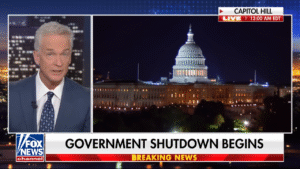Advertisements
The United States is now in the midst of a government shutdown, and the reasons behind it are causing confusion, frustration, and uncertainty across the nation. With millions of Americans relying on government services, the shutdown of 2025 is a reminder of the deep political divides that continue to paralyze the nation’s capital. The cause? A lack of agreement in Congress over federal funding for the upcoming fiscal year, which began on October 1, 2025.
While government shutdowns have become somewhat routine in U.S. politics over the years, the current situation feels different. This time, the division runs deeper, and the stakes are much higher. The underlying issue is a fierce battle over healthcare, particularly the future of the Affordable Care Act (ACA), also known as Obamacare. For many Americans, the ACA represents the difference between life-saving medical coverage and going without care. As the shutdown continues, the political gridlock shows no signs of easing.
Advertisements
The problem began when Congress failed to pass a necessary funding bill, one that would ensure the government could continue to function. The bill, a short-term funding measure, was supposed to keep the government running until November 21, 2025. However, partisan disagreement has made this impossible. The Republicans, who control both the House and the Senate, pushed for a funding bill that would include cuts to Medicaid and other healthcare programs. These cuts were part of President Trump’s broader plan to reduce federal spending.
On the other side, the Democrats, who are fiercely opposed to the cuts, have demanded that the bill include provisions to protect health insurance subsidies and extend Medicaid funding. The conflict over these healthcare measures has effectively brought the government to a standstill. Without a resolution, government services are frozen, and millions of federal workers face uncertainty about their paychecks. For those who rely on the government for critical services, the effects are immediate and severe.

The healthcare debate is at the heart of the shutdown. Democrats want to protect the Affordable Care Act, a cornerstone of healthcare policy in the U.S., while Republicans argue that government spending needs to be reined in. President Trump’s administration has backed cuts to Medicaid, which would affect millions of low-income Americans. These cuts are deeply unpopular among many voters, and the Democratic leadership, led by Senate Minority Leader Chuck Schumer and House Minority Leader Hakeem Jeffries, is refusing to back down.
The shutdown has also highlighted the influence of President Trump. Despite his party’s control of Congress, Trump’s refusal to negotiate or back off his positions has created additional tensions. The president has repeatedly clashed with Democratic leaders, and his decision to cancel talks only further entrenched the gridlock. This unwillingness to compromise has made it nearly impossible to reach a deal that would end the shutdown.
Meanwhile, the economic implications of the shutdown are already being felt. Federal workers, including those in essential positions like air traffic controllers and FBI agents, are either furloughed or forced to work without pay. Services that many Americans rely on—like Social Security, Medicare, and veterans’ benefits—are still functioning, but other services are in limbo. The longer the shutdown continues, the more strain it will put on both the economy and the public trust in government.
One of the most pressing issues is the potential delay in important economic data. Agencies like the Bureau of Labor Statistics, which tracks employment and inflation data, will be closed, and this critical information may not be released on time. This uncertainty makes it even harder for businesses and consumers to make informed decisions, potentially impacting everything from stock market investments to personal savings.
It’s also important to consider the long-term effects of the shutdown. If this deadlock continues, the economic damage could worsen. Many federal workers are already struggling, and with no resolution in sight, the toll on both government employees and the broader economy could grow more severe. The psychological impact on Americans, particularly those who depend on government assistance, cannot be ignored.
So, where do we go from here? The future remains uncertain. Both parties are deeply entrenched in their positions, and the president’s influence seems to be making it harder to find common ground. However, history shows that these shutdowns do eventually end, often after weeks or even months of negotiation. What’s clear is that the stakes are higher than ever before. With critical healthcare decisions hanging in the balance and the economy at risk, the U.S. government must find a way out of this gridlock—before the damage becomes irreversible.
Impact on Federal Workers and Services
| Issue | Details |
|---|---|
| Start of Shutdown | October 1, 2025 |
| Main Cause | Disagreement over healthcare funding, particularly cuts to Medicaid and the Affordable Care Act |
| Parties Involved | President Donald Trump, Republicans in Congress, Senate Minority Leader Chuck Schumer, House Minority Leader Hakeem Jeffries |
| Impact on Federal Workers | Furloughs and layoffs for non-essential federal workers, essential workers to continue working without pay |
| Services Affected | Federal agencies with non-essential functions, including the Bureau of Labor Statistics and economic data agencies |
| Potential Resolution | Uncertain; dependent on future negotiations and compromises |
| Reference Source | Al Jazeera on Government Shutdown |
Advertisements